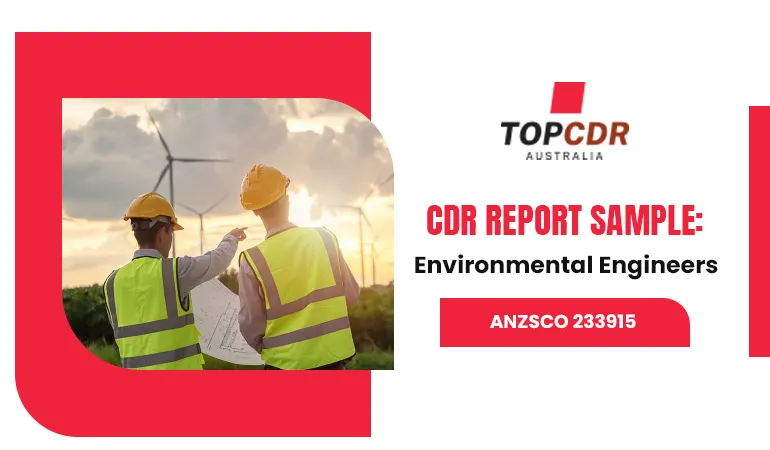CDR Sample For Environmental Engineer
CDR Report Samples Approved By Engineers Australia
Download the free CDR report samples written by our professional experts according to the Migration Skill Assessment guidelines.
Environmental Engineer ANZSCO 233915
CDR Sample for Environmental Engineer

CDR Sample: Environmental Engineer ANZSCO Code: 233915
The CDR Sample for Environmental Engineers includes all the necessary reports, such as Three Career Episodes, Continuing Professional Development Writing, and a Curriculum Vitae Summary Statement. The Content of the CDR Report Sample is as follows:
- Curriculum Vitae: Resume based on a professional template.
- Continuing Professional Development Sample: The CPD Sample clearly explains the author’s engineering knowledge (1000 words).
- Environmental Engineer Career Episode Sample 1: “Hydraulic Conductivity, Infiltration, and Runoff from No-Till and Tilled Cropland” (1850 words).
- Environmental Engineer Career Episode Sample 2: “Finding Robust Solutions Against Environmental Changes” (1700 words).
- Environmental Engineer Career Episode Sample 3: “Environmentally Friendly Pultrusion” (2100 words).
- Environmental Engineer Summary Statement Sample: A detailed explanation of all the competency elements (1500 words).
The CDR Sample for Environmental Engineer incorporates all the required reports, such as a Resume or Curriculum vitae (CV), Continuing Professional Development(CPD), 3 Career Episodes(CE), and a Summary Statement. The CDR Report Samples contain the following contents:
Resume:
Continuing Professional Development (CPDs)
Career Episodes:
Environmental Engineer Career Episode Report: Sample 1
Project Name: “Hydraulic Conductivity, Infiltration, and Runoff from No-till and Tilled Cropland.“
In the first career episode, the author describes the project he did for the partial fulfillment of requirements for the Degree of Master of Science. The project’s name was “Hydraulic Conductivity, Infiltration, and Runoff from No-till and Tilled Cropland”. The responsibilities of the author were:
To quantify the satiated hydraulic conductivity and runoff on center pivot irrigated, long-term no-till systems
To determine the effect of slot, ridge, and disk planting on the satiated hydraulic conductivity in a furrow irrigated field and measure satiated hydraulic conductivity on dryland tilled and no-till plots
To investigate factors that may increase the satiated hydraulic conductivity and decrease runoff
To study center pivot irrigated tilled and no-till fields to determine the effect of no-till planting on infiltration and runoff
To investigate four pedotransfer functions models: Crust Factor, ROSETTA, an equation used in the Water Erosion Prediction Project (WEPP) and Soil Water Characteristics tool (SWC) to determine which equation most accurately describes satiated hydraulic conductivity when both tilled and no-till fields are considered.
Environmental Engineer Career Episode Report: Sample 2
Finding Robust Solutions Against Environmental Changes
In the second Career Episode, the author prepared this thesis for the degree of Doctor of Philosophy. His duties and responsibilities in the project “Finding Robust Solutions Against Environmental Changes” were:
To describe ROOT problems and solutions to ROOT
To provide two benchmarks developed for ROOT
To propose a novel algorithm framework specially for solving ROOT
To demonstrate the advantage of the proposed framework by comparing a few representative TMO approaches with an instantiation of the proposed framework
To use dynamic handling strategy
Environmental Engineer Career Episode Report: Sample 3
Project Name: “Environmentally Friendly Pultrusion”.
In the third Career Episode, the author demonstrates the technical skills she used to complete the project she presented as her Bachelor’s degree. The project was “Environmentally Friendly Pultrusion”. The key responsibility of the writer was:

 Chat with us
Chat with us